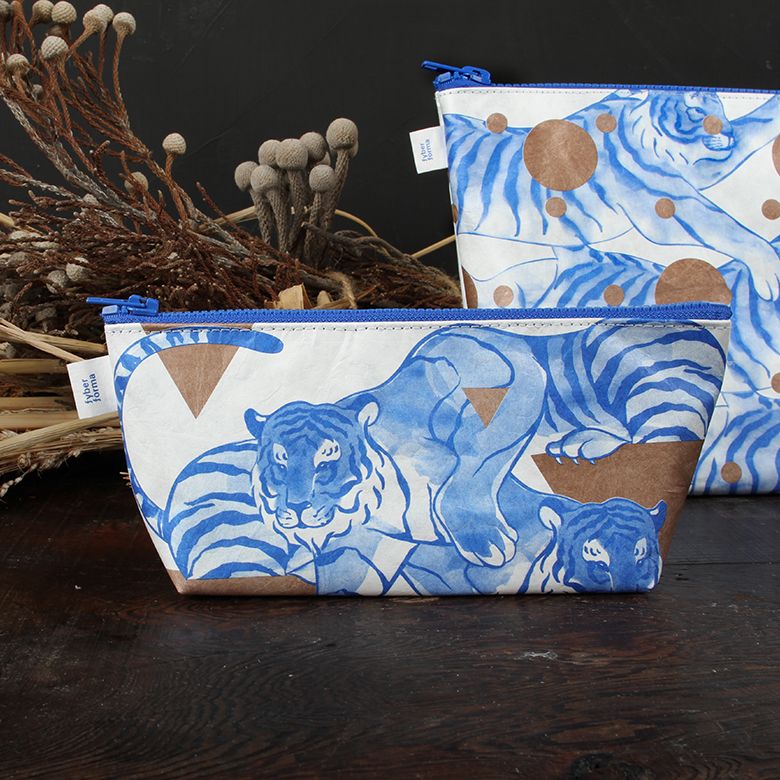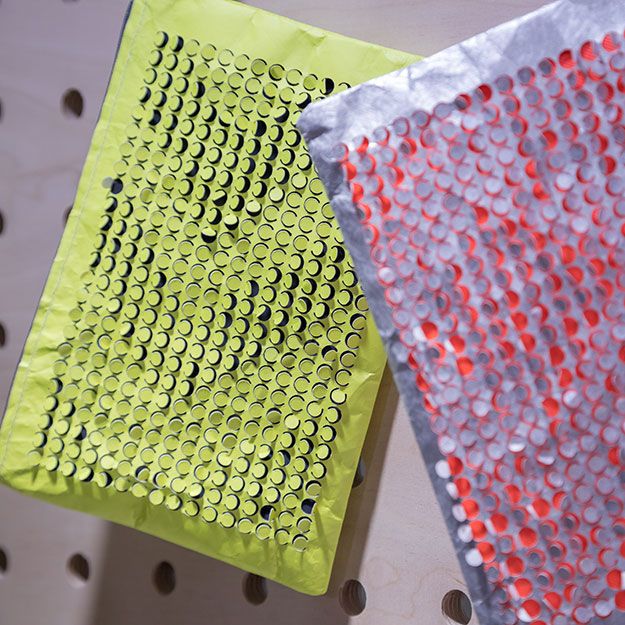
DuPont™ Tyvek® FAQs
Following frequently asked questions from end users about DuPont™ Tyvek® materials, here are professional answers from DuPont materials experts.
Q1: What kind of material is Tyvek®?
A: Tyvek® is formed from continuous, fine filaments of HDPE that are randomly distributed and non-directional. Tyvek® is available in two structures: “hard” (paper-like) and “soft” (fabric-like). Styles beginning with a 10 are “hard” and styles beginning with 14 or 16 are soft. Tyvek® is naturally white—the GE brightness of Tyvek® is 94.1 with no fillers or brightening agents.
Q2: What are the stock dimensions of Tyvek®?
A: Tyvek® is sold in rolls or in sheets. For the specific size and quantity for your project, please contact a Tyvek® sales team or Tyvek® distributor.
Q3: Does a Tyvek® sheet have front and back side? What is the difference?
A: The two sides of Tyvek® are a little bit different. The smooth side is the “front side” and the rough side is the “back side” (which can be identified by comparing the two sides). Most physical properties such as water resistance, strength, etc. of the two sides are basically the same. Type 10 materials can be printed on both sides, but for best print quality the smooth side is preferred. Type 14 materials should be printed on the smooth side.
Q4: Why is Tyvek® uneven in thickness?
A: Tyvek® is formed using continuous, randomly distributed and non-directional filaments; giving Tyvek® a unique appearance and resulting in thickness variation.
Q5: Why does Tyvek® become delaminated after being rubbed?
A: Tyvek® can internally delaminate—that is, the front side separates from the back side--if exposed to shearing forces, such as rubbing the surface, creasing, or bending at a sharp angle. In this respect, Tyvek® behaves as multilayer structure.
Q6: Is Tyvek® water resistant?
A: Tyvek® is equally strong wet or dry under ordinary conditions and ambient temperature (73.4°F [23°C]). Upon initial exposure, water will not penetrate Tyvek®. With time, or increased water pressure, drops of water will go through Tyvek®. It is suggested that customers should test the performance of Tyvek® for their specific application.
Q7: Is Tyvek® breathable?
A: Tyvek® is breathable, which means water vapor and gases can go through Tyvek®. The moisture vapor permeability of Tyvek® is much higher than that of plastic films. Compared to most textile fabrics, the air permeability of Tyvek® is low. Customers should evaluate Tyvek® in their specific application.
Q8: What is the dimensional stability of Tyvek®?
A: Tyvek® is dimensionally stable from -73°C to 100°C. Under tension, such as in printing or coating operations, we recommend that temperature not be higher than 79°C to avoid deformation of Tyvek®.
Q9: How is the folding endurance of Tyvek®?
A: Tyvek® is very flexible and can be folded over and over without damage. Maps and book lamps make good use of this feature. Tyvek® also has a memory effect, like paper.
Q10: What is the abrasion performance of Tyvek® surface?
A: Tyvek® is a non-woven material, and its abrasion performance cannot be compared with woven fabric. Increased abrasion performance can be achieved by lamination with another material. It is suggested that Customers should always evaluate the performance of Tyvek® for their specific application.
Q11: Is Tyvek® stretchable?
A: Tyvek® is limited in stretch.
Q12: What are the light reflection and light transmission properties of Tyvek®?
A: Laboratory tests show that Tyvek®, without any special treatment, has good reflectivity to visible lights —usually above 90%. The transmittance of visible lights is about 10%. It is suggested that customers evaluate for their specific application.
Q13: Is Tyvek® UV resistant? How long will it last for outdoor use?
A: Tyvek® is not considered UV resistant and we do not recommend Tyvek® for applications where constant sun exposure is expected. For intermittent or short-term sun exposure, some styles can be used, please consult DuPont sales for recommendation. It is suggested that customers test the UV performance of Tyvek® for their specific application.
Q14: Does Tyvek® have anti-mold and antimicrobial properties?
A: The antimicrobial requirements of a material depend on the specific industry and application in which it is used.
Q15: What is the chemical resistance of Tyvek®?
A: Tyvek® can resist most acidic and alkaline chemicals. For details, please refer to Tyvek® guidelines (they can be downloaded from website).
Q16: Is Tyvek® flame retardant? What is its melting point and ignition point?
A: Tyvek® should not be considered as flame retardant and its flammability is like most synthetic fibers. Tyvek® type 10 has been tested according to ASTM E84-89a with a class A rating. Type 14 Tyvek® has been tested according to 16 CFR 1610 with a class 1 rating. The melting point of Tyvek® is 135°C and the ignition point of high density polyethylene is approximately 400°C. Specific flame-retardant requirements can be met by applying a special coating to Tyvek®.
Q17: Is the surface of the Tyvek® antistatic treated and corona treated?
A: Styles ending in D or R are antistatic- and corona- treated to improve the processing and printability of Tyvek®.
Q18: Is Tyvek® suitable for direct contact with food?
A: Tyvek® used in printing industry (type D or type R) is not recommended to be used in direct contact with food, but there are some Tyvek® styles which can be used in direct contact with food. For details, contact a Tyvek® sales team or Tyvek® distributor.
Q19: What is the shelf life of Tyvek®? What are the storage conditions?
A: Tyvek® can be stored for many years indoors under controlled temperature and humidity. Do not store Tyvek® in direct sunlight. Store Tyvek® vertically on its ends, overwrapped with Tyvek® or polyethylene film. Core plugs should be in place when roll handling.
Q20: Is Tyvek® environmentally friendly?
A: Tyvek® is made from high density polyethylene and is 100% recyclable. Products made from printed, glued, welded, or sewn Tyvek® can be recycled, as can those made from Tyvek® with lamination or coating of materials from the same polymer family. Recycled Tyvek® can be made into products such as automotive parts, plastic film, packaging, outdoor furniture and decking. Tyvek® cannot be composted and does not readily biodegrade or decompose.
Q21: How do you recycle Tyvek®?
A: DuPont™ Tyvek® is made from 100% high-density polyethylene (HDPE). For this reason, pure Tyvek® can be recycled as HDPE.
Q22: Can we print on Tyvek®? How can you improve the color fastness?
A: Tyvek® is printable with traditional printing techniques as well as with many digital technologies. The color fastness depends on the ink and the printing technique. Work with your printer and ink supplier to determine the best ink for the application.
Q23: Can calico printing be used for printing on Tyvek®?
A: No, because the temperature of calico printing generally exceeds the melting point of Tyvek®.
Q24: Can digital printing be used for Tyvek®?
A: Yes. HP Indigo, UV inkjet, and Latex inkjet can be used to print on Tyvek®. Typical laser (dry toner electrophotography) is not recommended because the high temperature can melt Tyvek®. Water-based and solvent-based inkjet is possible on Tyvek® that has been coated with an appropriate primer.
Q25: Can Tyvek® be dyed?
A: The traditional dyeing process for cloth is not applicable for Tyvek®. But the surface of Tyvek® can be colored by printing.
Q26: Can I write or paint on the surface of Tyvek®? What kind of pen is appropriate?
A: You can write or paint on Tyvek®. General water-based pens are suitable for washable needs, alcohol-based pens are suitable for permanent writing or graffiti-art, and acrylic pigments are also suitable for painting on Tyvek®.
Q27: Can Tyvek® be punched or cut?
A: Yes. Tyvek® can be die-cut, punched, and laser cut.
Q28: Can Tyvek® be crumpled?
A: Yes.
Q29: Can Tyvek® be laminated? Will the process affect water resistant performance and breathability?
A: Yes, like woven materials, Tyvek® can be laminated with a variety of materials, the breathability and water resistant properties may be changed depending on the materials selected for lamination.
Q30: Can Tyvek® be glued?
A: Yes. Water-based adhesive, solvent adhesive, animal glue, hot melt adhesive and so on can be used for Tyvek® gluing. When selecting an adhesive, consider the composition of the materials to be glued, the processing conditions, and the end-use conditions. Some adhesives contain ingredients (such as plasticizers, solvents, or monomers) that can distort Tyvek®. Work with your adhesive supplier to select and thoroughly test the adhesive for your application, before beginning mass production.
Q31: Can Tyvek® be sewn? How can a sewn seam be strengthened and water resistant performance improved in the sewn area of Tyvek®?
A: It can be sewed like a fabric. Because Tyvek® is a non-woven fabric, it can be reinforced at the sewn area by adding other woven fabrics to improve the seam strength. In addition, composite materials or PU coating materials can be used if the overall water resistance performance needs to be improved, and water resistance tape can be used if the water-resistant performance of sewn area needs to be improved.
Q32: Can ultrasonic sealing be used for Tyvek®?
A: Yes. Customers should determine the right equipment and settings for their specific application.
Q33: What is the tear strength and joint slip property of apparel made of Tyvek®?
A: There is no data on this aspect of Tyvek® application in apparel. We recommend that the customer make an evaluation based on their specific application.
Q34: Can you mark the material description on the finished product label?
A: If it is a pure Tyvek® finished product, the material composition can be marked as 100% high-density polyethylene; if it is made of various composited or coated materials, it cannot be marked with 100% high density polyethylene. In that case, the customer needs to label the product composition according to the materials selected.
Q35: Can apparel or bags made of Tyvek® be washed with water? How can they be cleaned?
A: Yes. For light cleaning, wipe with a damp cloth. For heavier cleaning, wash the item by hand or gentle machine cycle in cool water with mild detergent. Hang to dry. Do not machine dry. Do not bleach.
Q36: Can PU coated Tyvek® clothes be cleaned?
A: Yes. For the washing method, refer to the answer to the previous question Q35.
Q37: Can Tyvek® be ironed?
A: Ironing is not recommended, because the heat of the iron will melt or damage Tyvek®, Tyvek® melts at 135°C.
For more information, please click to download: DuPont™ Tyvek® User Guide.
Note: This information is based upon technical data that DuPont believes to be reliable. It is subject to revision as additional knowledge and experience are gained. It is intended for use by persons having technical skill for evaluation under their specific end-use conditions at their own discretion and risk. Since conditions of use are outside our control, WE MAKE NO WARRANTIES, EXPRESSED OR IMPLIED, INCLUDING WITHOUT LIMITATIONS, NO WARRANTIES OF MERCHANTABILITY OR FITNESS FOR A PARTICULAR USE AND ASSUME NO LIABILITY IN CONNECTION WITH ANY USE OF THIS INFORMATION. This information is not intended as a license to operate under or a recommendation to infringe any patent or technical information of DuPont or others covering any material or its use.



